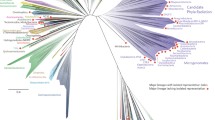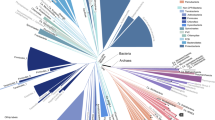Abstract
The Tree of Life hypothesis frames the evolutionary process as a series of events whereby lineages diverge from one another, thus creating the diversity of life as descendent lineages modify properties from their ancestors. This hypothesis is under scrutiny due to the strong evidence for lateral gene transfer between distantly related bacterial taxa, thereby providing extant taxa with more than one parent. As a result, one argues, the Tree of Life becomes confounded as the original branching structure is gradually superseded by reticulation, ultimately losing its ability to serve as a model for bacterial evolution. Here we address a more fundamental issue: is there a Tree of Life that results from bacterial evolution without considering such lateral gene transfers? Unlike eukaryotic speciation events, lineage separation in bacteria is a gradual process that occurs over tens of millions of years, whereby genetic isolation is established on a gene-by-gene basis. As a result, groups of closely related bacteria, while showing robust genetic isolation as extant lineages, were not created by an unambiguous series of lineage-splitting events. Rather, a temporal fragmentation of the speciation process results in cognate genes showing different genetic relationships. We argue that lineage divergence in bacteria does not produce a tree-like framework, and inferences drawn from such a framework have the potential to be incorrect and misleading. Therefore, the Tree of Life is an inappropriate paradigm for bacterial evolution regardless of the extent of gene transfer between distantly related taxa.







Similar content being viewed by others
References
Bapteste E, Susko E, Leigh J, MacLeod D, Charlebois RL, Doolittle WF (2005) Do orthologous gene phylogenies really support tree-thinking? BMC Evol Biol 5:33
Bapteste E, O’Malley MA, Beiko RG, Ereshefsky M, Gogarten JP, Franklin-Hall L, Lapointe FJ, Dupré J, Dagan T, Boucher Y, Martin W (2009) Prokaryotic evolution and the tree of life are two different things. Biol Direct 4:34
Boyd R (1999) Homeostasis, species, and higher taxa. In: Wilson R (ed) Species: new interdisciplinary essays. MIT Press, Cambridge, pp 141–185
Butela K, Lawrence JG (2009) Selection for antigenic diversity in Salmonella. In: Falush D, Robinson A (eds) Bacterial population genetics in infectious disease. Wiley-Blackwell, London (in press)
Cohan FM (2001) Bacterial species and speciation. Syst Biol 50:513–524
Darwin C (1859) On the origin of species by means of natural selection or the preservation of favoured races in the struggle for life. John Murray, London
Doolittle WF (2000) Uprooting the tree of life. Sci Am 282:90–95
Doolittle WF, Bapteste E (2007) Pattern pluralism and the tree of life hypothesis. Proc Natl Acad Sci USA 104:2043–2049
Dykhuizen DE, Green L (1991) Recombination in Escherichia coli and the definition of biological species. J Bacteriol 173:7257–7268
Falush D, Torpdahl M, Didelot X, Conrad DF, Wilson DJ, Achtman M (2006) Mismatch induced speciation in Salmonella: model and data. Philos Trans R Soc Lond B Biol Sci 361:2045–2053
Feil EJ, Spratt BG (2001) Recombination and the population structures of bacterial pathogens. Annu Rev Microbiol 55:561–590
Feil EJ, Holmes EC, Bessen DE, Chan MS, Day NP, Enright MC, Goldstein R, Hood DW, Kalia A, Moore CE, Zhou J, Spratt BG (2001) Recombination within natural populations of pathogenic bacteria: short-term empirical estimates and long-term phylogenetic consequences. Proc Natl Acad Sci USA 98:182–187
Fraser C, Hanage WP, Spratt BG (2007) Recombination and the nature of bacterial speciation. Science 315:476–480
Gevers D, Cohan FM, Lawrence JG, Spratt BG, Coenye T, Feil EJ, Stackebrandt E, Van de Peer Y, Vandamme P, Thompson FL, Swings J (2005) Re-evaluating prokaryotic species. Nat Rev Microbiol 3:733–739
Gogarten JP, Doolittle WF, Lawrence JG (2002) Prokaryotic evolution in light of gene transfer. Mol Biol Evol 19:2226–2238
Gordon DM, Cowling A (2003) The distribution and genetic structure of Escherichia coli in Australian vertebrates: host and geographic effects. Microbiology 149:3575–3586
Guttman DS (1997) Recombination and clonality in natural populations of Escherichia coli. Trends Ecol Evol 12:16–22
Guttman DS, Dykhuizen DE (1994a) Clonal divergence in Escherichia coli as a result of recombination, not mutation. Science 266:1380–1383
Guttman DS, Dykhuizen DE (1994b) Detecting selective sweeps in naturally occurring Escherichia coli. Genetics 138:993–1003
Hanage WP, Fraser C, Spratt BG (2005) Fuzzy species among recombinogenic bacteria. BMC Biol 3:6
Huson DH, Bryant D (2006) Application of phylogenetic networks in evolutionary studies. Mol Biol Evol 23:254–267
Joly S, McLenachan PA, Lockhart PJ (2009) A statistical approach for distinguishing hybridization and incomplete lineage sorting. Am Nat 174:E54–E70
Koonin EV, Wolf YI (2009) The fundamental units, processes and patterns of evolution, and the tree of life conundrum. Biol Direct 4:33
Kudva IT, Evans PS, Perna NT, Barrett TJ, Ausubel FM, Blattner FR, Calderwood SB (2002a) Strains of Escherichia coli O157:H7 differ primarily by insertions or deletions, not single-nucleotide polymorphisms. J Bacteriol 184:1873–1879
Kudva IT, Evans PS, Perna NT, Barrett TJ, DeCastro GJ, Ausubel FM, Blattner FR, Calderwood SB (2002b) Polymorphic amplified typing sequences provide a novel approach to Escherichia coli O157:H7 strain typing. J Clin Microbiol 40:1152–1159
Lawrence JG (2002) Gene transfer in bacteria: speciation without species? Theor Popul Biol 61:449–460
Lawrence JG, Retchless AC (2009) The interplay of homologous recombination and horizontal gene transfer in bacterial speciation. Methods Mol Biol 532:29–53
Lederberg J (1947) Gene recombination and linked segregations in Escherichia coli. Genetics 32:505–525
Lederberg J, Tatum EL (1946) Gene recombination in Escherichia coli. Nature 158:558
Levin BR (1981) Periodic selection, infectious gene exchange and the genetic structure of E. coli populations. Genetics 99:1–23
Maynard Smith J, Smith NH, O’Rourke M, Spratt BG (1993) How clonal are bacteria? Proc Natl Acad Sci USA 90:4384–4388
Mayr E (1942) Systematics and the origin of species. Columbia University Press, New York
Mayr E (1954) Change of genetic environment and evolution. In: Huxley JS, Hardy AC, Ford EB (eds) Evolution as a process. Allen and Unwin, London, pp 156–180
Mayr E (1963) Animal species and evolution. Harvard University Press, Cambridge
Nakata N, Tobe T, Fukuda I, Suzuki T, Komatsu K, Yoshikawa M, Sasakawa C (1993) The absence of a surface protease, OmpT, determines the intercellular spreading ability of Shigella: the relationship between the ompT and kcpA loci. Mol Microbiol 9:459–468
Ochman H, Wilson AC (1988) Evolution in bacteria: evidence for a universal substitution rate in cellular genomes. J Mol Evol 26:74–86
Ochman H, Lawrence JG, Groisman E (2000) Lateral gene transfer and the nature of bacterial innovation. Nature 405:299–304
Ogura Y, Ooka T, Iguchi A, Toh H, Asadulghani M, Oshima K, Kodama T, Abe H, Nakayama K, Kurokawa K, Tobe T, Hattori M, Hayashi T (2009) Comparative genomics reveal the mechanism of the parallel evolution of O157 and non-O157 enterohemorrhagic Escherichia coli. Proc Natl Acad Sci USA 106:17939–17944
Pamilo P, Nei M (1988) Relationships between gene trees and species trees. Mol Biol Evol 5:568–583
Retchless AC, Lawrence JG (2007) Temporal fragmentation of speciation in bacteria. Science 317:1093–1096
Stevenson G, Neal B, Liu D, Hobbs M, Packer NH, Batley M, Redmond JW, Lindquist L, Reeves P (1994) Structure of the O antigen of Escherichia coli K-12 and the sequence of its rfb gene cluster. J Bacteriol 176:4144–4156
Templeton AR (1989) The meaning of species and speciation: a genetic perspective. In: Otte D, Endler JA (eds) Speciation and its consequences. Sinauer Associates, Sunderland, pp 3–27
Van Valen L (1976) Ecological species, multispecies, and oaks. Taxon 25:223–239
Vulic M, Dionisio F, Taddei F, Radman M (1997) Molecular keys to speciation: DNA polymorphism and the control of genetic exchange in Enterobacteria. Proc Natl Acad Sci USA 94:9763–9767
Vulic M, Lenski RE, Radman M (1999) Mutation, recombination, and incipient speciation of bacteria in the laboratory. Proc Natl Acad Sci USA 96:7348–7351
Walk ST, Alm EW, Calhoun LM, Mladonicky JM, Whittam TS (2007) Genetic diversity and population structure of Escherichia coli isolated from freshwater beaches. Environ Microbiol 9:2274–2288
Walk ST, Alm EW, Gordon DM, Ram JL, Toranzos GA, Tiedje JM, Whittam TS (2009) Cryptic lineages of the genus Escherichia. Appl Environ Microbiol 75:6534–6544
Welch RA, Burland V, Plunkett G 3rd, Redford P, Roesch P, Rasko D, Buckles EL, Liou SR, Boutin A, Hackett J, Stroud D, Mayhew GF, Rose DJ, Zhou S, Schwartz DC, Perna NT, Mobley HL, Donnenberg MS, Blattner FR (2002) Extensive mosaic structure revealed by the complete genome sequence of uropathogenic Escherichia coli. Proc Natl Acad Sci USA 99:17020–17024
Wertz JE, Goldstone C, Gordon DM, Riley MA (2003) A molecular phylogeny of enteric bacteria and implications for a bacterial species concept. J Evol Biol 16:1236–1248
Wildschutte H, Lawrence JG (2007) Differential Salmonella survival against communities of intestinal amoebae. Microbiology 153:1781–1789
Wildschutte H, Wolfe DM, Tamewitz A, Lawrence JG (2004) Protozoan predation, diversifying selection, and the evolution of antigenic diversity in Salmonella. Proc Natl Acad Sci USA 101:10644–10649
Wiley EO (1978) The evolutionary species concept reconsidered. Syst Zool 27:17–26
Xiang SH, Haase AM, Reeves PR (1993) Variation of the rfb gene clusters in Salmonella enterica. J Bacteriol 175:4877–4884
Zawadzki P, Roberts MS, Cohan FM (1995) The log-linear relationship between sexual isolation and sequence divergence in Bacillus transformation is robust. Genetics 140:917–932
Acknowledgments
This work was support by grant GM078092 from the National Institutes of Health. The paper was first presented at the workshop, Perspectives on the Tree of Life, sponsored by the Leverhulme Trust and held in Halifax, Nova Scotia, July, 2009.
Author information
Authors and Affiliations
Corresponding author
Rights and permissions
About this article
Cite this article
Lawrence, J.G., Retchless, A.C. The myth of bacterial species and speciation. Biol Philos 25, 569–588 (2010). https://doi.org/10.1007/s10539-010-9215-5
Published:
Issue Date:
DOI: https://doi.org/10.1007/s10539-010-9215-5




